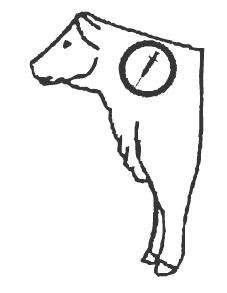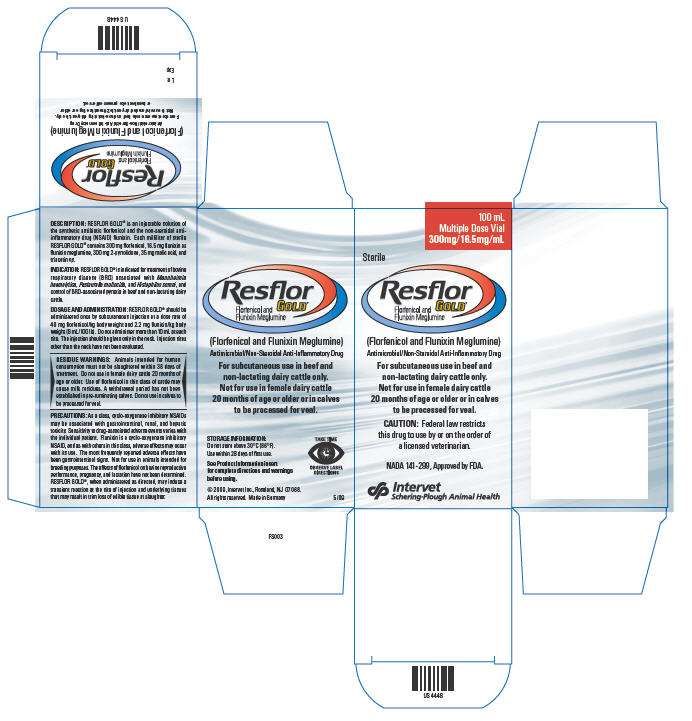Resflor Gold
Resflor GOLD
FULL PRESCRIBING INFORMATION: CONTENTS*
- CAUTION
- RESFLOR GOLD DESCRIPTION
- INDICATION
- RESFLOR GOLD DOSAGE AND ADMINISTRATION
- RESFLOR GOLD CONTRAINDICATIONS
- WARNINGS
- PRECAUTIONS
- RESIDUE WARNINGS
- RESFLOR GOLD ADVERSE REACTIONS
- CLINICAL PHARMACOLOGY
- MICROBIOLOGY
- EFFECTIVENESS
- ANIMAL SAFETY
- STORAGE INFORMATION
- HOW SUPPLIED
- PRINCIPAL DISPLAY PANEL - 100 mL Carton
FULL PRESCRIBING INFORMATION
(Florfenicol and Flunixin Meglumine)
Antimicrobial/Non-Steroidal Anti-Inflammatory Drug
For subcutaneous use in beef and non-lactating dairy cattle only.
Not for use in female dairy cattle 20 months of age or older or in calves to be processed for veal.
PRODUCT INFORMATION
CAUTION
Federal law restricts this drug to use by or on the order of a licensed veterinarian.
RESFLOR GOLD DESCRIPTION
RESFLOR GOLD® is an injectable solution of the synthetic antibiotic florfenicol and the non-steroidal anti-inflammatory drug (NSAID) flunixin. Each milliliter of sterile RESFLOR GOLD® contains 300 mg florfenicol, 16.5 mg flunixin as flunixin meglumine, 300 mg 2-pyrrolidone, 35 mg malic acid, and triacetin qs.
INDICATION
RESFLOR GOLD® is indicated for treatment of bovine respiratory disease (BRD) associated with Mannheimia haemolytica, Pasteurella multocida, and Histophilus somni, and control of BRD-associated pyrexia in beef and non-lactating dairy cattle.
RESFLOR GOLD DOSAGE AND ADMINISTRATION
RESFLOR GOLD® should be administered once by subcutaneous injection at a dose rate of 40 mg florfenicol/kg body weight and 2.2 mg flunixin/kg body weight (6 mL/100 lb). Do not administer more than 10 mL at each site. The injection should be given only in the neck. Injection sites other than the neck have not been evaluated. For the 500mL vial, do not puncture the stopper more than 10 times.
|
RESFLOR GOLD® Dosage Guide |
||
|
ANIMAL WEIGHT (lb) |
DOSAGE (mL) |
|
| 100 | 6.0 | Recommended Injection Location 
|
| 200 | 12.0 | |
| 300 | 18.0 | |
| 400 | 24.0 | |
| 500 | 30.0 | |
| 600 | 36.0 | |
| 700 | 42.0 | |
| 800 | 48.0 | |
| 900 | 54.0 | |
| 1000 | 60.0 | |
RESFLOR GOLD CONTRAINDICATIONS
Do not use in animals that have shown hypersensitivity to florfenicol or flunixin.
WARNINGS
NOT FOR HUMAN USE. KEEP OUT OF REACH OF CHILDREN. This product contains material that can be irritating to skin and eyes. Avoid direct contact with skin, eyes, and clothing. In case of accidental eye exposure, flush with water for 15 minutes. In case of accidental skin exposure, wash with soap and water. Remove contaminated clothing. Consult a physician if irritation persists. Accidental injection of this product may cause local irritation. Consult a physician immediately. The Material Safety Data Sheet (MSDS) contains more detailed occupational safety information.
For customer service or to obtain a copy of the MSDS, call 1-800-211-3573. For technical assistance or to report suspected adverse reactions, call 1-800-219-9286.
PRECAUTIONS
As a class, cyclo-oxygenase inhibitory NSAIDs may be associated with gastrointestinal, renal, and hepatic toxicity. Sensitivity to drug-associated adverse events varies with the individual patient. Patients at greatest risk for adverse events are those that are dehydrated, on diuretic therapy, or those with existing renal, cardiovascular, and/or hepatic dysfunction. Concurrent administration of potentially nephrotoxic drugs should be carefully monitored. NSAIDs may inhibit the prostaglandins that maintain normal homeostatic function. Such anti-prostaglandin effects may result in clinically significant disease in patients with underlying or pre-existing disease that have not been previously diagnosed. Since many NSAIDs possess the potential to produce gastrointestinal ulceration, concominant use of RESFLOR GOLD® with other anti-inflammatory drugs, such as NSAIDs or corticosteroids, should be avoided or closely monitored.
Flunixin is a cyclo-oxygenase inhibitory NSAID, and as with others in this class, adverse effects may occur with its use. The most frequently reported adverse effects have been gastrointestinal signs. Events involving suspected renal, hematologic, neurologic, dermatologic, and hepatic effects have also been reported for other drugs in this class.
Not for use in animals intended for breeding purposes. The effects of florfenicol on bovine reproductive performance, pregnancy, and lactation have not been determined. Toxicity studies in dogs, rats, and mice have associated the use of florfenicol with testicular degeneration and atrophy. NSAIDs are known to have potential effects on both parturition and the estrous cycle. There may be a delay in the onset of estrus if flunixin is administered during the prostaglandin phase of the estrous cycle. The effects of flunixin on imminent parturition have not been evaluated in a controlled study. NSAIDs are known to have the potential to delay parturition through a tocolytic effect.
RESFLOR GOLD®, when administered as directed, may induce a transient reaction at the site of injection and underlying tissues that may result in trim loss of edible tissue at slaughter.
RESIDUE WARNINGS
Animals intended for human consumption must not be slaughtered within 38 days of treatment. Do not use in female dairy cattle 20 months of age or older. Use of florfenicol in this class of cattle may cause milk residues. A withdrawal period has not been established in pre-ruminating calves. Do not use in calves to be processed for veal.
RESFLOR GOLD ADVERSE REACTIONS
Transient inappetence, diarrhea, decreased water consumption, and injection site swelling have been associated with the use of florfenicol in cattle. In addition, anaphylaxis and collapse have been reported post-approval with the use of another formulation of florfenicol in cattle. In cattle, rare instances of anaphylactic-like reactions, some of which have been fatal, have been reported, primarily following intravenous use of flunixin meglumine.
CLINICAL PHARMACOLOGY
The pharmacokinetics (PK) of florfenicol (Table 1) and flunixin (Table 2) after subcutaneous injection of RESFLOR GOLD® is described below:
| Mean Florfenicol PK parameters in Cattle | ||||||
|---|---|---|---|---|---|---|
| PK Parameter |
AUC 0-t
 (ng*hr/mL) |
AUC0-inf
 (ng*hr/mL) |
Cmax
 (ng/mL) |
Tmax
 |
T½
 |
MRT0-inf
 (hr) |
| Mean | 242527 | 247577 | 11151 | 6.25 | 28.5 | 27.3 |
SD |
42741 | 41391 | 4194 | 3.87 | 9.91 | 11.6 |
| Mean Flunixin PK parameters in Cattle | ||||||
|---|---|---|---|---|---|---|
| PK Parameter |
AUC 0-t
 (ng*hr/mL) |
AUC0-inf
 (ng*hr/mL) |
Cmax
 (ng/mL) |
Tmax
 |
T½
 |
MRT0-inf
 (hr) |
| Mean | 13370 | 14448 |
1913 | 1.14 | 9.5 |
11.4 |
SD
 |
4964 | 5116 | 791 | 0.97 | 3.27 | 4.41 |
MICROBIOLOGY
Florfenicol is a synthetic, broad-spectrum antibiotic active against many Gram-negative and Gram-positive bacteria isolated from domestic animals. It acts by binding to the 50S ribosomal subunit and inhibiting bacterial protein synthesis. Florfenicol is generally considered a bacteriostatic drug, but exhibits bactericidal activity against certain bacterial species. In vitro studies demonstrate that florfenicol is active against the BRD pathogens M. haemolytica, P. multocida, and H. somni, and that florfenicol exhibits bactericidal activity against strains of M. haemolytica and H. somni.
The minimum inhibitory concentrations (MICs) of florfenicol were determined for BRD isolates obtained from calves enrolled in BRD field studies in the U.S. in 2006 using methods recommended by the Clinical and Laboratory Standards Institute (M31-A2). Isolates were obtained from pre-treatment nasal swabs from all calves enrolled at all four sites, post-treatment nasal swabs from treatment failures in the RESFLOR GOLD and saline control treatment groups at three sites, and lung tissue from one calf that died in the saline control treatment group. The results are shown in Table 3.
| Indicated pathogens | Year of isolation | Number of isolates | MIC50
 (μg/mL) |
MIC90
 (μg/mL) |
MIC range (μg/mL) |
|---|---|---|---|---|---|
| Mannheimia haemolytica | 2006 | 183 | 1.0 | 1.0 | 0.5 to 32 |
| Pasteurella multocida | 2006 | 139 | 0.5 | 0.5 | ≤ 0.125 to 16 |
| Histophilus somni | 2006 | 84 | ≤ 0.125 | ≤ 0.125 | ≤ 0.125 to 0.25 |
EFFECTIVENESS
In a multi-site field study, calves with naturally-occurring BRD were treated with RESFLOR GOLD®, Nuflor Gold® (NADA 141-265), or saline. A treatment success was defined as a calf with normal respiration to mild respiratory distress, normal attitude to mildly depressed, and a rectal temperature < 104.0 °F on Day 11. The treatment success rate for BRD for the RESFLOR GOLD® treatment group (68.4%) was statistically significantly greater (p = 0.0255) compared to the saline control treatment group (42.9%). RESFLOR GOLD® was non-inferior to Nuflor Gold® for the treatment of BRD, with a one-sided 95% lower confidence bound for the difference between the two treatments equal to -13.2%.
In the same study, the change in rectal temperature from pre-treatment to six hours post-treatment was evaluated to determine the effectiveness of RESFLOR GOLD® for the control of BRD-associated pyrexia. The proportion of calves whose rectal temperatures decreased by ≥ 2.0 °F from pre-treatment to six hours post-treatment was statistically significantly greater (p = 0.0019) in the RESFLOR GOLD® treatment group compared to the saline control treatment group. The mean decrease in rectal temperature from pre-treatment to six hours post-treatment was statistically significantly greater in the RESFLOR GOLD® treatment group compared to the Nuflor Gold® and saline control treatment groups (p = 0.0031 and 0.0002, respectively).
ANIMAL SAFETY
A target animal safety study was conducted to evaluate the effects of RESFLOR GOLD® when administered to cattle subcutaneously at 1X, 3X, or 5X the labeled dose for three consecutive days (3X the labeled duration). Decreased feed and water consumption, and decreased body weights (secondary to decreased feed consumption) were observed in the 1X, 3X, and 5X groups. Injection site swellings were noted in the 1X, 3X, and 5X groups.
A separate injection site study was conducted in cattle. The study demonstrated that RESFLOR GOLD®, when administered according to the label directions, may induce a transient local reaction in the subcutaneous and underlying muscle tissue.
STORAGE INFORMATION
Do not store above 30°C (86°F). Use within 28 days of first use.
HOW SUPPLIED
RESFLOR GOLD® is available in 100, 250, and 500 mL sterile, multiple-dose, glass vials.
Made in Germany
Intervet Inc. Roseland, NJ 07068
©2009, Intervet Inc. All rights reserved.
May 2009
US 3448 V
NADA 141-299, Approved by FDA.
US 3448 R
PRINCIPAL DISPLAY PANEL - 100 mL Carton
100 mL
Multiple Dose Vial
300mg/16.5mg/mL
Sterile
Resflor
GOLD
®
Florfenicol and
Flunixin Meglumine
(Florfenicol and Flunixin Meglumine)
Antimicrobial/Non-Steroidal Anti-Inflammatory Drug
For subcutaneous use in beef and
non-lactating dairy cattle only.
Not for use in female dairy cattle
20 months of age or older or in calves
to be processed for veal.
CAUTION: Federal law restricts
this drug to use by or on the order of
a licensed veterinarian.
NADA 141-299, Approved by FDA.
Intervet
Schering-Plough Animal Health

Resflor GoldFlorfenicol and Flunixin Meglumine INJECTION
| |||||||||||||||||||||||||||||||||||||||||||||||||||||||||||||||||||||||